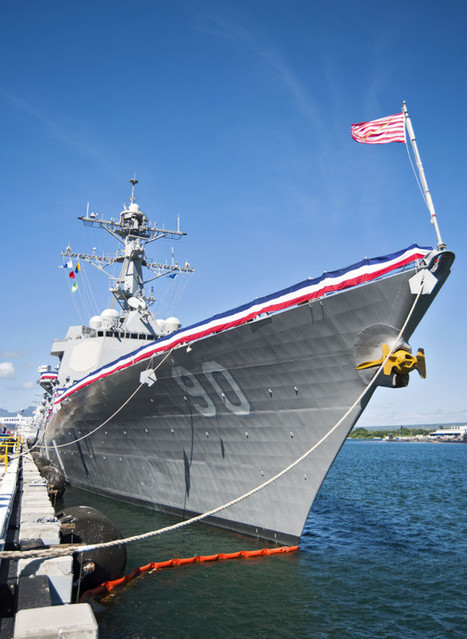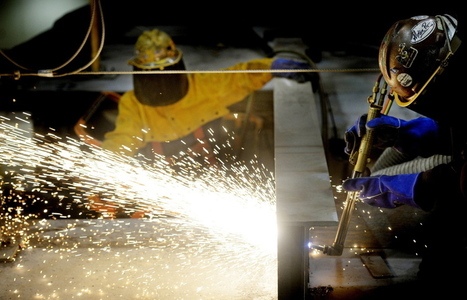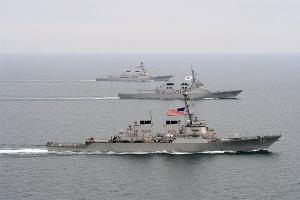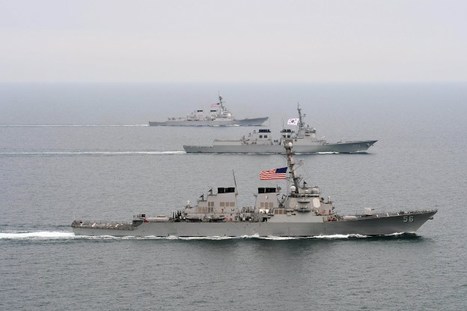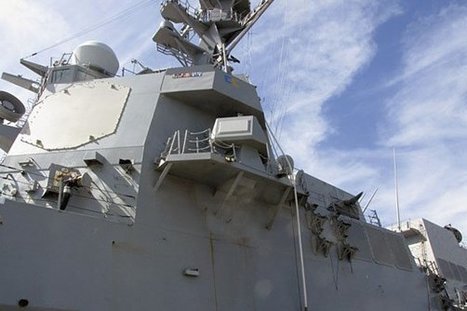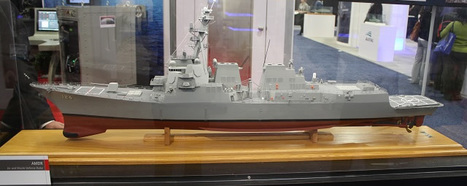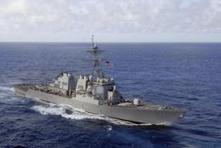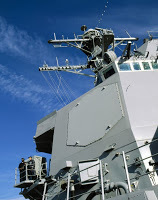 Your new post is loading...

|
Scooped by
Patrick H.
|
Five Arleigh Burke-class guided missile destroyers (DDG-51) will forgo a combat system upgrade that would allow the ships to fight ballistic missile threats as part of a reduction in modernization funding included in the Navy’s Fiscal Year (FY) 2016 budget that will save the service $500 million over the next five years, USNI News has learned. Modernization periods for five Flight IIA Burkes — USS Howard (DDG-83); USS McCampbell (DDG-85); USS Mustin (DDG-89); USS Chafee (DDG-90); USS Bainbridge (DDG-96) — will not include the Baseline 9C Aegis Combat System series of processing power and software upgrades to bring an Integrated Air and Missile Defense (IAMD) capability to the destroyers, according to an unclassified version of the current modernization plan seen by USNI News. Instead, the ships will undergo a much more modest upgrade that will focus on hull, mechanical and electrical (HM&E) systems repairs, leaving the ships — all commissioned between 2001 to 2004 — without any ballistic missile defense (BMD) capability. Additionally — without the Baseline 9 upgrade — the ships will not be wired into the Navy’s emerging Naval Integrated Fire Control-Counter Air (NIFC-CA (pronounced: nifk-kah)) that would allow destroyers to download targeting information from assets outside of the range of their SPY-1D radars to attack air and BMD threats with the Raytheon Standard Missile 6 (SM-6). The budget line item in FY 2016 budget reduces modernization funding by $63.1 million — about what it would cost to upgrade a ship to Baseline 9 — which precluded the Baseline 9 upgrade for Howard. Equivalent cuts to the Burke modernization line in the Navy’s Future Years Defense Plan (FYDP) — about $500 million over five years, USNI News understands — created a knock-on effect for the McCampbell, Mustin, Chafee and Bainbridge modernizations preventing the service from buying long-lead materials for the ships and allowing even a basic BMD capability, USNI News has learned. When asked about the reductions following a House appropriations hearing on Thursday, Chief of Naval Operations (CNO) Adm. Jonathan Greenert told USNI News the cuts were a result of hard fiscal choices and reflected the service’s priorities.

|
Scooped by
Patrick H.
|
BATH — Bath Iron Works is hiring hundreds of new workers this year and launching an on-site training facility as the shipyard enters a phase when crews will be working on six Navy destroyers simultaneously. BIW officials said they expect to hire about 600 people by the end of the year, elevating the shipyard’s workforce to nearly 6,000 for the first time since 2004. The hiring spree is a response to the fact that six destroyers – representing two entirely different designs – will be at various stages of construction at the General Dynamics-owned shipyard. “That is more (work) than we have dealt with in a long, long time,” said Edward Kenyon, manager of the DDG-51 destroyer program at BIW. With roughly 5,450 workers, BIW is one of Maine’s largest private employers. It is also one of the Navy’s primary shipyards and has benefited from a steady stream of new Navy contracts in recent years despite the budget cuts and financial uncertainty that have gripped Washington. “The feeling is pretty good about the backlog. However, we know we have to perform on it,” said Jay Wadleigh, president of the Local S6 chapter of the International Association of Machinists and Aerospace Workers union. Tight federal budgets and higher expectations will keep pressure on BIW to control costs, Wadleigh said. BIW will be working on three DDG-51 Arleigh Burke destroyers, which are updated variants on a destroyer class in Navy service for more than two decades, and three DDG-1000 Zumwalt destroyers. The first of the “stealth” Zumwalt destroyers is pier-side at BIW, undergoing final construction before at-sea testing next year. Large sections of the second Zumwalt and the next Arleigh Burke are also under construction at the yard. TRAINING FACILITY CREATED Shipyard officials said they will be hiring a broad range of skilled workers, including electricians, pipe fitters, outside machinists, welders and tinsmiths, as well as electrical, structural and mechanical engineers. Although most new workers arrive at BIW with prior experience or training in their field, shipyard officials have created a training facility to help workers tailor those skills to the shipyard’s needs. For instance, the high-voltage electrical power system in the Zumwalt destroyers operates at 4,160 volts, compared to the 110-volt systems that are standard in most residences and businesses. The training facility, which opened on a limited basis in recent weeks, is set up like an industrial classroom with stations such as welding, pipe-bending, brazing and stud-welding. The program’s Rick Blair said new recruits will spend two to six weeks in training, depending on the trade. In addition to the work-related expansion, the company also is bracing for a steady wave of retirements in the coming years. The average BIW tradesman has worked there for 20 years, said BIW spokesman Matt Wickenheiser. “We expect we are going to need to continue training new workers for years to come because of that aging workforce,” Kenyon said. “It also means there will be great opportunities for people who live in the area.” Wadleigh said BIW officials told his union that they could hire between 600 and 1,000 workers this year, depending on the rate of attrition.

|
Scooped by
Patrick H.
|
ROTA, Spain (NNS) -- The forward-deployed Arleigh Burke-class guided-missile destroyer USS Donald Cook (DDG 75) departed Naval Station Rota, Spain in support of maritime security operations and theater security cooperation efforts in the U.S. 6th Fleet area of operations, March 14.
Donald Cook is the first of four destroyers to be part of the Navy's Forward Deployed Naval Forces in Rota which is part of the Phased Adaptive Approach to protect European allies, partners, U.S. forces in the region, and the U.S. homeland against current and emerging ballistic missile threats.
"From theater security cooperation in the Mediterranean, to NATO exercises and training, to maritime security operations, this ship is capable of conducting prompt, sustained combat operations at sea in support of U.S. national policy," said Cmdr. Scott Jones, Donald Cook's commanding officer.
While on patrol in the U.S. 6th Fleet area of operations, Donald Cook will perform numerous missions, including NATO missile defense, maritime security operations, bilateral and multilateral training exercises.
U.S. 6th Fleet, headquartered in Naples, Italy, conducts a full range of maritime security operations and theater security cooperation missions in concert with coalition, joint, interagency, and other parties in order to advance security and stability in Europe and Africa.

|
Scooped by
Patrick H.
|
The U.S. Navy is in the early phases of a series of engineering and combat systems modernization upgrades to its current fleet of 62 commissioned Arleigh Burke-class destroyers, service officials said. The planned upgrades are what the Navy calls "Hull, Mechanical & Electrical" or "HME" modernizations. Separate combat systems upgrades are also part of the effort, Navy officials said. "Every year you have a ship out there is a significant investment in fuel, people and spare parts. What you want is to keep the ship combat relevant so it continues to be able to perform the full range of missions against all the modern threats throughout its life," Capt. Mark Vandroff, program manager for DDG 51 acquisition, told Military.com. "The ships are getting new bridge control consuls. With the automation and the decision making tools for the bridge-watch standards, you can watch from a bridge that has more information available with potentially fewer people and a higher level of situational awareness," Vandroff said. The HME upgrades, which have been completed on a handful of ships, also look at the ship's infrastructure to check for stability, corrosion and hull damage. "A DDG 51 has got to be able to fight and withstand a reasonable amount of battle damage, so you need to keep up with things like corrosion, hull strength and paint," he explained. "If you look at one of the ships that have been through the HME modernization and look at one of its tanks and its bilges -- it looks like a ship that could last another 15 years."The Navy's fleet of DDG 51s is broken down into several categories determined largely by chronology and technology. The first DDG 51s, the Flight 1s, were built with a vertical launch system for missiles, five-inch guns and a Close-In-Weapons-System, or CWIS, for ship defense. The Flight 1 ships, which include DDG numbers 51 through 71, were built with one landing pad for helicopters, Vandroff explained. Flight II, which includes ship numbers 72 to 78, adds an organic signals intelligence capability to the ship, he said. Flight IIAs, the most numerous of the Arleigh Burke class-destroyers, are built with two helicopter hangars. The Flight IIA ships, which include DDG 79 and forward, are also configured with advanced electronics, computing and combat systems compared to prior models. Four new Flight IIA DDG 51s are now under contract for construction, ships 113 through 116. The ships, slated to begin service by 2016, are named the USS John Finn, USS Ralph Johnson, USS Rafael Peralta and USS Thomas Hudner, Navy officials said. The midlife modernization upgrades will replace the Flight 1 ship's data multi-plexing system which used an early local area network with gigabit ethernet cables and modern computing technology, Vandroff said. Also, 1980s-era processors get replaced with modern computers, sensors and cameras to monitor the engine room and other parts of the ship. Manual logs and data collection is replaced by an integrated system with cameras and computers able to monitor trends and other key signals aboard the ship, Vandroff added. The Navy's USS John Paul Jones, DDG 53, is an Aegis destroyer which has successfully completed both the HME and combat systems upgrades, Vandroff said. The ship is uniquely configured because it has also been equipped with the latest in integrated ballistic missile defense software, Aegis Weapons System 5.0. This technology, which includes the use of a multi-mission signal processor, allows the ship to conduct air defense and ballistic missile defense mission concurrently, Vandroff explained. One analyst said the Navy's DDG 51 midlife upgrades could pave the way for integration of newer emerging technologies such as lasers and electromagnetic rail guns.

|
Scooped by
Patrick H.
|
The Navy is confident it has enough space, power and cooling onboard the hull of its planned new line of destroyers to accommodate the planned high-powered Air and Missile Defense Radar (AMDR), Capt. Mark Vandroff, Naval Sea Systems Command program manager for the DDG-51 shipbuilding program, told USNI News in an interview on Thursday. However, the Arleigh Burke- class destroyer (DDG-51) Flight III would be limited in the amount of additional weapons the ship could accommodate — including electromagnetic railguns and high-energy lasers — without removing other capabilities. “Depending on how heavy that railgun is, could you fit it on a DDG? My answer is what on that DDG are you willing to live without right now?” Vandroff said. “You wouldn’t have the space and weight to put on something very large without something relatively sizable coming off.” As part of a Monday $6.1 billion, nine-ship deal, the service plans to procure three Flight III DDGs beginning in Fiscal Year 2016. The ships will be the first designed for use with the AMDR that will have an emphasis on ballistic missile defense. The AMDR plans to be a 14 ft. aperture S-band radar (ballistic missile defense and air defense), X-band radar (horizon search) and radar suite controller that will replace the current Lockheed Martin SPY-1D radar found on the current Burke Flight IIAs. The Navy’s original plan was to procure a new 20,000 ton next-generation cruiser (CG(X)) that would field the AMDR and undertake the BMD mission. The CG(X) program was cancelled in 2010 and the 30 year-old Burkes were restarted to take the BMD role. In order to accommodate the increased power demands of the AMDR, NAVSEA plans to replace the four existing three-megawatt generators on the ship with the same number of four-megawatt generators to accommodate the extra power. “That will very comfortably serve this radar and the entire ship running at full battle capability,” Vandroff said. The Navy’s plan to extend the DDG line into Flight III has come under criticism by Congress and the Government Accountability Office. The GAO found in 2012, “the inclusion of the AMDR on the existing DDG-51 hull to significant risks in the ship’s design and a reduced future capacity and could result in design and construction delays and cost growth on the lead ship.” Rep. Randy Forbes (R-Va.) , the chairman of the House Armed Services Subcommittee on Seapower and Projection forces called for the Navy to send a report to Congress on the growth margins for the Flight III ships. Though the Navy has planned for Flight III for the last three of the ship deal, there is an option for the service to build the ships in the current Flight IIA configuration with the current Aegis weapons system. “It is on purpose an alterable plan, in that I could execute those ships as Flight IIAs,” Vandroff said.
“I don’t want to be flip, but plans change. In the [budget] environment we’re in now plans might change.”
|

|
Scooped by
Patrick H.
|
Lockheed Martin Mission Systems and Training has completed the installation of a first SLQ-32(V) shipborne electronic warfare (EW) system upgraded under Block 2 of the US Navy's (USN's) Surface Electronic Warfare Improvement Program (SEWIP). According to the company, the DDG 51 Arleigh Burke-class Flight IIA guided-missile destroyer USS Bainbridge received the SEWIP Block 2 system in July for operational testing. The Block 2 implementation has received the in-service designation AN/SLQ-32(V)6. Established in 2002, the SEWIP programme encompasses a set of incremental upgrades for the legacy SLQ-32 EW system. Originally developed by Raytheon, and fielded from the late 1970s onwards, SLQ-32 is a family of shipborne EW outfits providing detection, analysis, threat warning, and (in some variants) electronic attack functionality.

|
Scooped by
Patrick H.
|
The preliminary design of the US Navy's (USN's) Flight III Arleigh Burke-class guided-missile destroyer features a wider stern than the current Flight IIA ships in order to accommodate the new Air and Missile Defense Radar (AMDR), the DDG 51 programme manager said on 7 April. Captain Mark Vandroff explained that because the AMDR arrays are heavier than the AN/SPY-1D(V) radar arrays on board Flight IIA ships, the stern modification was necessary to lower the Flight III destroyer centre of gravity. "The wider stern will displace more water, so you get more buoyant force .... That allows you to make the ship heavier and still keep the same waterline," he told IHS Jane's at the Navy League Sea Air Space Exposition in National Harbor, Maryland. Source Navy Recognition : During Sea-Air-Space 2014, Tad Dickenson (Raytheon's Program Manager Air and Missile Defense Radar) explained that the AMDR is over 30 times more powerful than the existing SPY-1 radar meaning it can put over 30 times more energy allowing to detect more targets, a lot further out. AMDR ranges about 2.5 times further compared to existing DDG 51 radar.

|
Scooped by
Patrick H.
|
Le premier des quatre destroyers lance-missiles déployés par les Etats-Unis dans le cadre de l’European Phased Adaptive Approach va arriver en Espagne vers le 10 février. L'EPAA (approche adaptative phasée) prévoit la mise en place en quatre phases, jusqu’à 2020, de missiles SM-3 sur des plates-formes navales (AEGIS) puis à terre (Roumanie et Pologne). Ces quatre destroyers AEGIS seront basé à Rota, près de Cadix (Espagne). Il s'agit des USS Ross (photo ci-dessus), USS Donald Cook et USS Porter, qui viendront de Norfolk, et de l'USS Carney de Mayport. Le Ross et le Donald Cook arriveront au cours de l'année fiscale 2014 et les deux destroyers suivants au cours de l'année fiscale 2015.

|
Scooped by
Patrick H.
|
WASHINGTON, Oct 22 (Reuters) - Lockheed Martin Corp, the Pentagon's top supplier and maker of the Aegis combat system, on Tuesday said it had filed a formal protest against the U.S. Navy's decision to award a next-generation radar contract to Raytheon Co. Lockheed spokesman Keith Little said the company decided to file a protest with the U.S. Government Accountability Office (GAO) because it did not believe the merits of its bid were properly considered during the Navy's evaluation process. "After careful consideration, Lockheed Martin has protested the Navy's award of the Air and Missile Defense Radar (AMDR) contract," Little said. "We submitted a technically compliant solution at a very affordable price." Lockheed's protest came as lawmakers from New Jersey, where Lockheed builds the Aegis system and related radars, raised concerns about the Raytheon contract award, arguing that it would be more expensive than the Lockheed proposal. Lockheed filed the protest late on Tuesday with the GAO, an arm of Congress that oversees disputes about federal contract awards, Little said. The agency now has 100 days to review the protest, with its ruling expected by Jan. 30. Raytheon earlier this month beat out Lockheed and Northrop Grumman Corp to win the contract to design a next-generation air and missile defense radar for use on the Navy's Aegis destroyers starting in 2016. Under the contract, Raytheon will build and test the new air and missile defense radar that will replace the existing SPY-1 radar built by Lockheed. A Northrop spokesman declined comment when asked whether the company had protested the contract award by Tuesday's deadline. Officials at Raytheon and at the Navy could not be reached for immediate comment on Lockheed's protest, which is expected to trigger a stop-work notice from the Navy. Lockheed Chief Executive Marillyn Hewson told analysts earlier on Tuesday, before the company filed its formal GAO protest, that the company was evaluating a briefing it received last week from the Navy about its decision. "We've been engaged on it, the Aegis system, for the past 42 years," she said. "We had deep understanding of that program and of the mission, so we were certainly disappointed." New Jersey lawmakers sent a letter to Navy Secretary Ray Mabus dated Oct. 16 in which they expressed concern about the Navy's decision to begin working with a new company given what they called the "unprecedented success" of the Aegis system. The lawmakers, from both the Democratic and Republican parties, asked Mabus to have the Navy reexamine its decision and brief the New Jersey delegation on why and how it was made. A copy of the letter was obtained by Reuters. They said Lockheed offered "the lowest cost AMDR solution," one that was low-risk, affordable, and technologically mature. Lockheed's proposal also represented the best value for the new radar given its record of investment in radar technology, according to the letter, which was signed by Senators Robert Menendez and Jeff Chiesa, and seven members of the House of Representatives. As well as past investment in SPY-1 radar technology, Lockheed also offered $135 million in direct investment in the new program and $70 million capital improvements at the Moorestown site in New Jersey, which first opened in 1954, according to the letter. "We are most concerned that the Navy's AMDR contract award decision, if implemented, would incur significant costs at this time of severe defense budget restrictions," they wrote, saying the decision could result in $400 million of extra costs.

|
Scooped by
Patrick H.
|
WASHINGTON — Construction contracts worth more than $6 billion were awarded Monday to shipbuilders General Dynamics and Huntington Ingalls to build nine new DDG 51 Arleigh Burke-class destroyers, the US Navy announced, with an option for a tenth ship. The awards keep destroyer construction humming at a pace that has been maintained since the DDG 51 class was restarted in 2009. Huntington Ingalls Industries (HII) received a $3,331,476,001 fixed-price-incentive firm target (FPIF) contract for the design and construction of five ships, one each in fiscal 2013 to 2017, the Navy said in a press release. The ships will all be built at the company’s Ingalls shipyard in Pascagoula, Miss. General Dynamics Bath Iron Works (BIW) was awarded a $2,843,385,450 FPIF contract for the design and construction of four ships, one in 2013 and one each in 2015 to 2017. The award also includes a contract option for a fifth ship, which, if approved, about be added to 2014. The Navy officially has asked Congress to fund one ship in 2014, but is seeking multi-year procurement (MYP) authority to add a second ship in 2014, hence the option for another ship. Congress is generally disposed to support adding the ship, and the service, in a press release, said it is working with Capitol Hill “to resolve funding shortfalls resulting from sequestration reductions before contracting the tenth ship.” HII received the five-ship MYP award due to a lower bid, which works out to about $666 million per ship. BIW’s four-ship award comes to nearly $711 million per ship. The contract awards do not include high-priced government-furnished equipment (GFE) bought separately by the Navy. GFE includes such major items as the Aegis combat system and all weapon systems. The construction awards, Navy said, are based on “a competitive allocation strategy used in the DDG 51 class shipbuilding program since 1996. Known as profit related to offers, or PRO, [the strategy] uses FPIF contracts to ensure reasonable prices while maintaining the industrial base. “Congressional approval for the use of MYP contracts facilitated program budget savings of more than $1.5 billion while enabling the shipbuilders and equipment manufacturers to more efficiently plan future workloads,” the Navy said in its press release. The nine-ship MYP awarded June 3 includes hull numbers DDG 117 through 125. The addition of a tenth ship would extend the contract through DDG 126. Two ships already are funded in 2013, the Paul Ignatius (DDG 117), which will be built at Ingalls, and the Bath-build Daniel Inouye (DDG 118). The yet-to-be-named DDG 119, requested in the 2014 budget, will be built at Ingalls. Initially, the new ships will be built to the Flight IIA version of the Arleigh Burke class, to which all ships since DDG 79 have been completed. Starting with the second ship in 2016, however, a significant addition, the new Air and Missile Defense Radar (AMDR), will be introduced to replace the SPY-1D radars in current ships. The AMDR, which will continue to work with the Aegis combat system, will have greater capabilities for the ballistic missile defense role, but also will require greater installed power and other design changes. An AMDR contractor has yet to be chosen, although later this year the Navy is expected to select a radar from either Lockheed Martin, Raytheon or Northrop Grumman. The switch to the Flight III will be contractually handled as an “engineering change proposal,” the Navy said. It is not yet decided which hull, or which shipbuilder, will handle the first Flight III ship. Should Congress fund only one ship in 2014, Ingalls would also get DDG 120 in 2015, with DDG 121 going to Bath. That would work out to Bath building the first AMDR ship, which would be DDG 123. Should the second 2014 ship be added, DDG 120 would become a Bath ship, and the second 2016 ship would become DDG 124, built at Ingalls. It is also possible construction of the first AMDR ship could slide and be awarded at a later date, although that is not now the Navy’s intention. Bath Iron Works continues as the DDG 51 program’s lead design shipyard, a position it has held since the 1980s. Arleigh Burke destroyers currently under construction include the John Finn (DDG 113) and Ralph Johnson (DDG 114) at Ingalls, and the Rafael Peralta (DDG 115) and Thomas Hudner (DDG 116) at Bath.
|



 Your new post is loading...
Your new post is loading...

